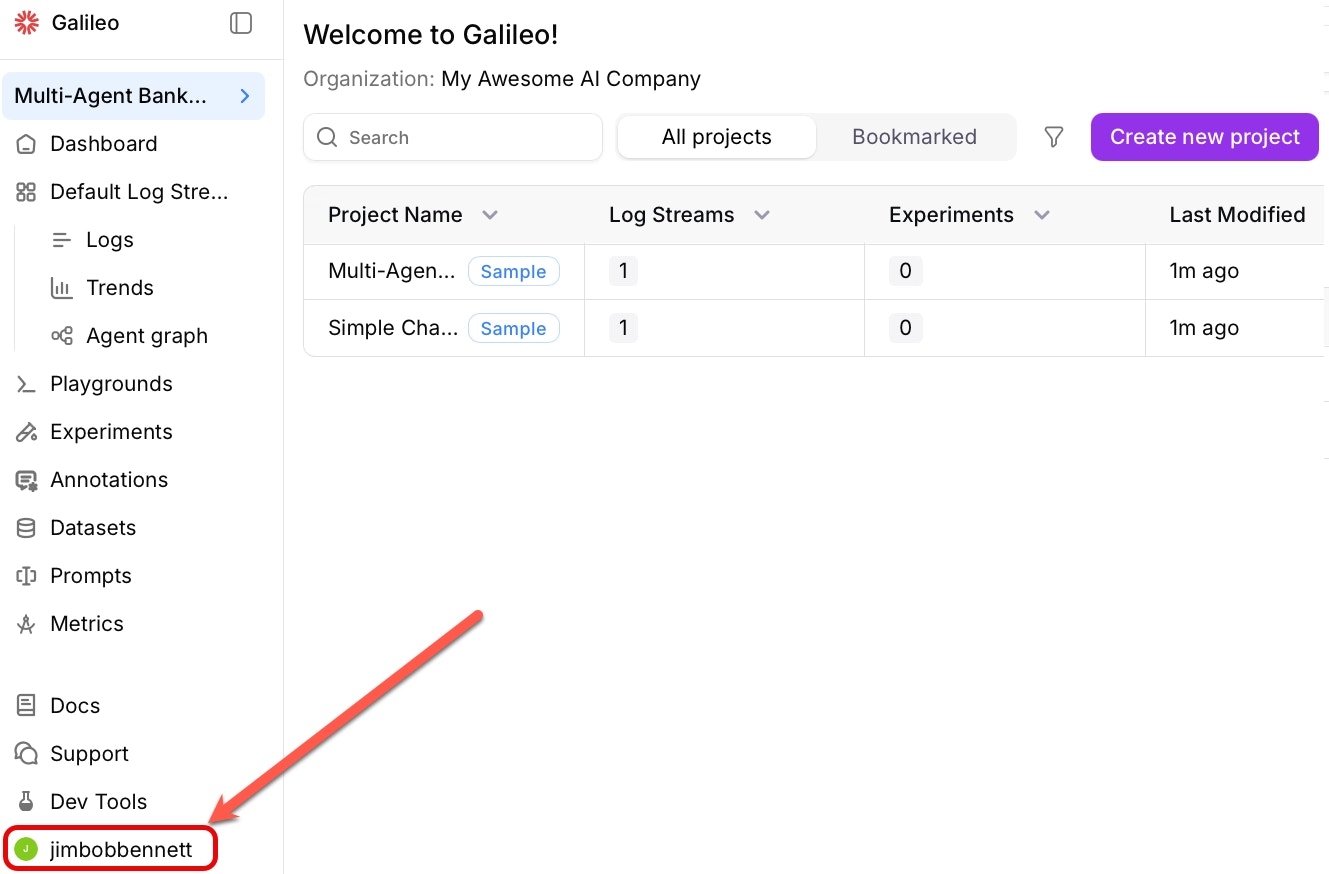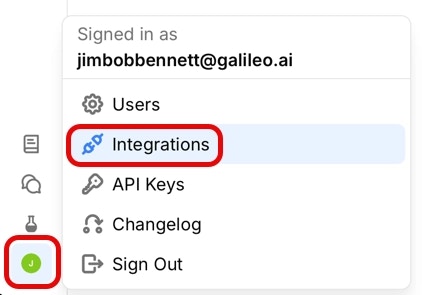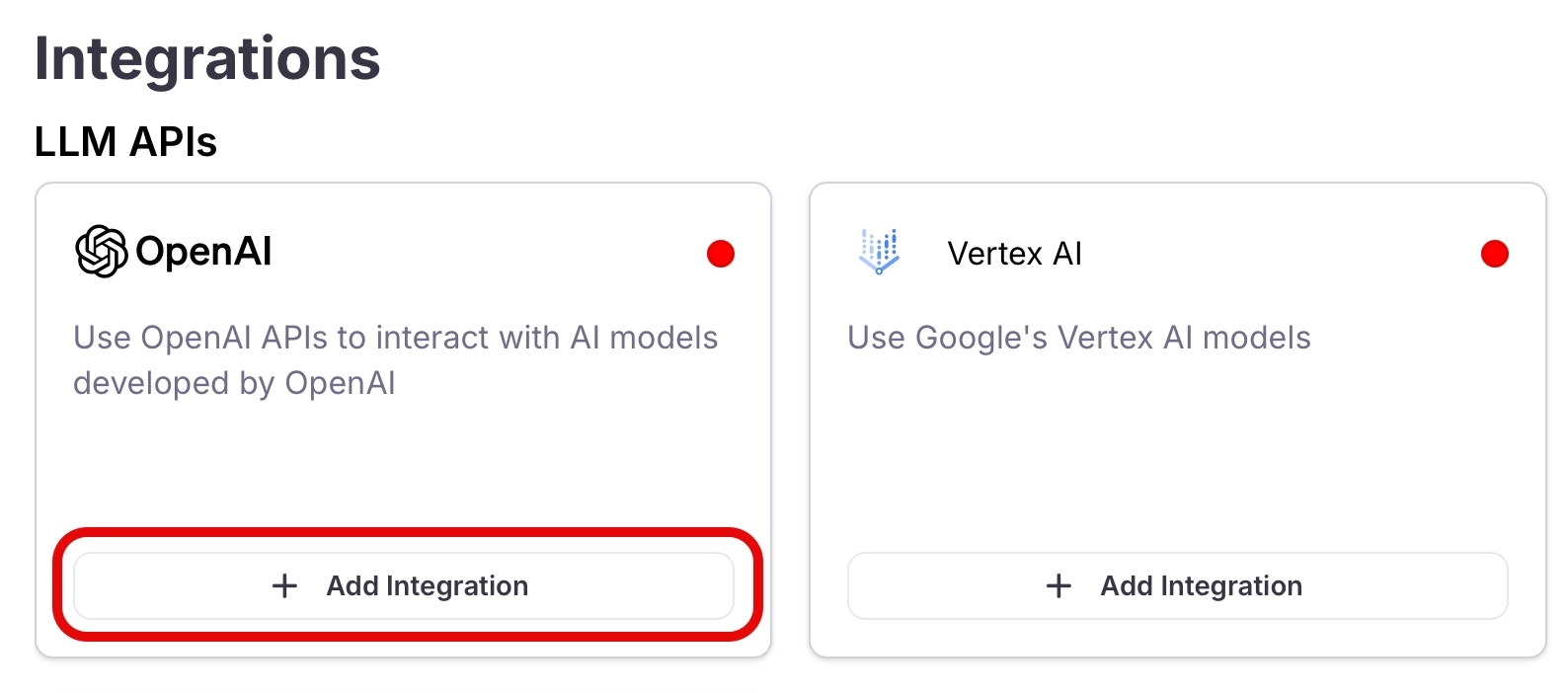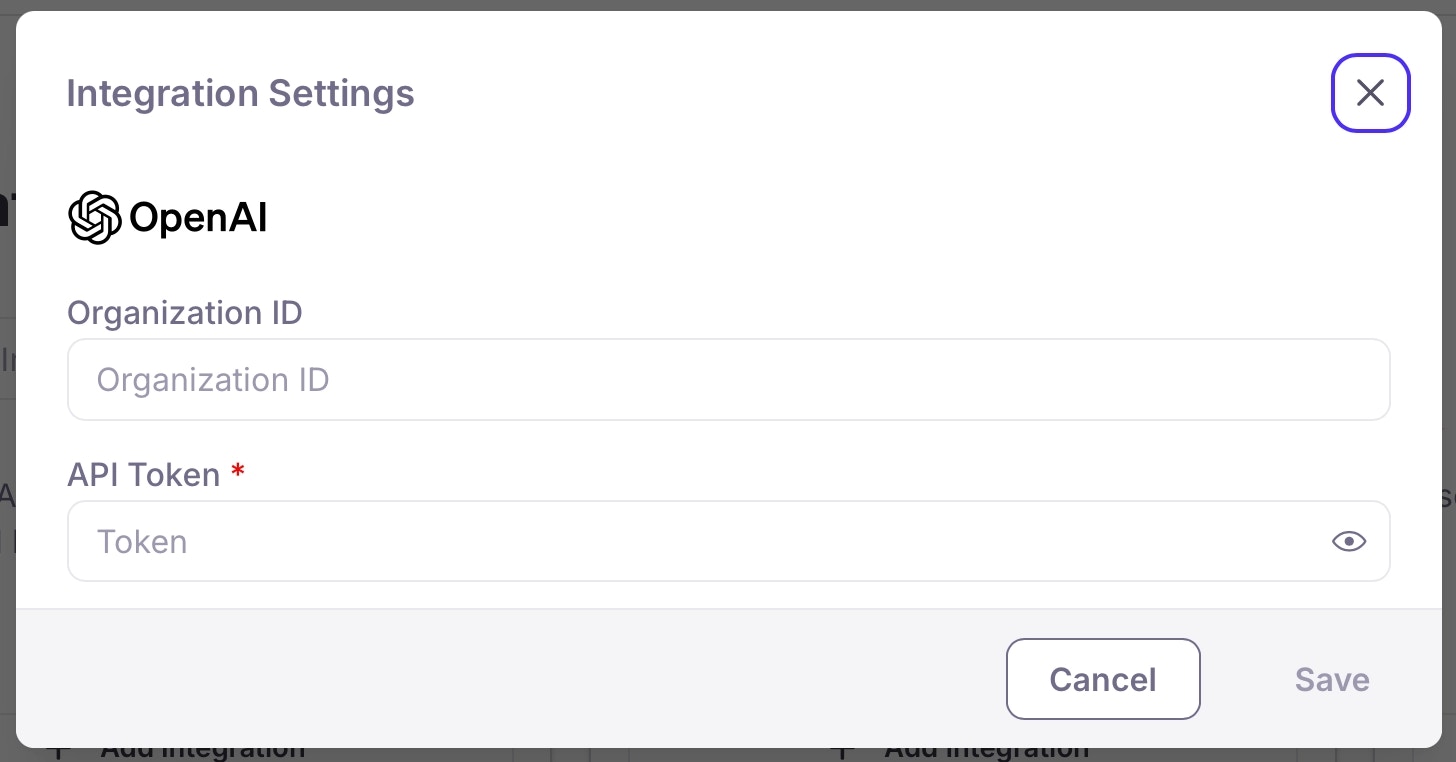Configure Galileo for out-of-the-box and LLM-as-a-judge metrics
LLM-based metrics use an LLM to evaluate inputs and outputs. To use these metrics from Log streams or experiments, you need to configure an integration with an LLM platform.1
Select the user menu
Select the user menu in the bottom left.

2
Open the integrations page
Select Integrations from the user menu.

3
Add an integration
Locate the option for the LLM platform you are using, then select the +Add Integration button.

4
Add the settings
Set the relevant settings for your integration, such as your API keys or endpoints. Then select Save.

Using metrics effectively
To get the most value from Galileo’s metrics:- Start with key metrics - Focus on metrics most relevant to your use case
- Establish baselines - Understand your current performance before making changes
- Track trends over time - Monitor how metrics change as you iterate on your system
- Combine multiple metrics - Look at related metrics together for a more complete picture
- Set thresholds - Define acceptable ranges for critical metrics
- Improve the metrics - Use CLHF to continuously improve the metrics
Out-of-the-Box metric categories
Our metrics can be broken down into five key categories, each addressing a specific aspect of AI system performance. Many times, folks benefit from using metrics from more than one category, depending on the metrics that matter most to them. Galileo also supports custom metrics that are able to be implemented alongside the out-of-the-box metric options.| Category | Description | When to Use | Example Use Cases |
|---|---|---|---|
| Agentic | Metrics that evaluate how effectively AI agents perform tasks, use tools, and progress toward goals. | When building and optimizing AI systems that take actions, make decisions, or use tools to accomplish tasks. |
|
| Expression and Readability | Metrics that evaluate the style, tone, clarity, and overall presentation of AI-generated content. | When the format, tone, and presentation of AI outputs are important for user experience or brand consistency. |
|
| Model Confidence | Metrics that measure how certain or uncertain your AI model is about its responses. | When you want to flag low-confidence responses for review, improve system reliability, or better understand model uncertainty. |
|
| Response Quality | Metrics that assess the accuracy, completeness, relevance, and overall quality of AI-generated responses. | When evaluating how well AI systems answer questions, follow instructions, or provide information based on context. |
|
| Safety and Compliance | Metrics that identify potential risks, harmful content, bias, or privacy concerns in AI interactions. | When ensuring AI systems meet regulatory requirements, protect user privacy, and avoid generating harmful or biased content. |
|
Agentic performance metrics
Use these metrics to evaluate how well your AI agents use tools, make decisions, and accomplish multi-step tasks. They’re a good fit when you’re building agents that need to interact with external systems or complete complex workflows.| Name | Description | Supported Nodes | When to Use | Example Use Case |
|---|---|---|---|---|
| Action advancement | Measures how effectively each action advances toward the goal. | Trace | When assessing whether an agent is making meaningful progress in multi-step tasks. | A travel planning agent that needs to book flights, hotels, and activities in the correct sequence. |
| Action completion | Determines whether the agent successfully accomplished all of the user’s goals. | Session | To assess whether an agent completed the desired goal. | A coding agent that is seeking to close engineering tickets. |
| Agent efficiency | Determines if an agent provides a precise answer or resolution to every user ask, with an efficient path. | Session | To assess if an agent is taking the most efficient path to a solution. | A complex multi-agent chatbot that needs a fast response. |
| Agent flow | Measures the correctness and coherence of an agentic trajectory by validating it against user-specified natural language tests. | Session | To assess a multi-agent system, or a system with multiple tools. | An internal process agent that needs to follow strict process rules. |
| Conversation quality | A binary metric that assesses whether a chatbot interaction left the user feeling satisfied and positive or frustrated and dissatisfied. | Session (trace inputs/outputs only) | When building customer facing chatbots. | A health insurance chatbot. |
| Tool error | Detects errors or failures during the execution of tools. | Tool span | When implementing AI agents that use tools and want to track error rates. | A coding assistant that uses external APIs to run code and must handle and report execution errors appropriately. |
| Tool selection quality | Evaluates whether the agent selected the most appropriate tools for the task. | LLM span | When optimizing agent systems for effective tool usage. | A data analysis agent that must choose the right visualization or statistical method based on the data type and user question. |
| User Intent change | Measures a significant shift in the user’s primary conversational goal or workflow during a session, relative to their initial stated intent. | Session (trace inputs/outputs only) | To analyze a holistic view across an entire user session to understand what capabilities a user interacts with in a single session. | A multi-purpose chatbot for a bank. |
Expression and readability metrics
Use these metrics to assess the style, tone, and clarity of your AI’s generated content. They’re helpful when you want your AI to communicate clearly, match your brand’s voice, or produce content that’s easy for users to understand.| Name | Description | Supported Nodes | When to Use | Example Use Case |
|---|---|---|---|---|
| Tone | Evaluates the emotional tone and style of the response. | Trace (root input/output only) | When the style and tone of AI responses matter for your brand or user experience. | A luxury brand’s customer service chatbot that must maintain a sophisticated, professional tone consistent with the brand image. |
| BLEU & ROUGE | Standard NLP metrics for evaluating text generation quality. These metrics are only available for experiments as they need ground truth set in your dataset. | LLM span | When you want to quantitatively assess the similarity between generated and reference texts. | Evaluating the quality of machine-translated or summarization outputs against human-written references. |
Model confidence metrics
Use these metrics to understand how certain or uncertain your AI model is about its answers. They’re useful when you want to flag low-confidence responses for review or improve your system’s reliability.| Name | Description | Supported Nodes | When to Use | Example Use Case |
|---|---|---|---|---|
| Prompt Perplexity | Evaluates how difficult or unusual the prompt is for the model to process. | LLM span | When you want to identify prompts that may confuse the model or lead to lower-quality responses. | Detecting outlier prompts in a customer support chatbot to improve prompt engineering. |
| Uncertainty | Measures the model’s confidence in its generated response. | LLM span | When you want to understand how certain the model is about its answers. | Flagging responses where the model is unsure, so a human can review them before sending to a user. |
Response quality metrics
Use these metrics to evaluate how well your AI answers user questions and follows instructions. They’re especially helpful when you want to ensure your system is providing accurate, complete, and relevant responses.| Name | Description | Supported Nodes | When to Use | Example Use Case |
|---|---|---|---|---|
| Chunk Attribution Utilization | Assesses whether the response uses the retrieved chunks in its response, and properly attributes information to source documents. | Retriever span | When implementing RAG systems and want to ensure proper attribution and that retrieved information is used efficiently. | A legal research assistant that must cite specific cases and statutes when providing legal information. |
| Completeness | Measures how thoroughly the response covers the relevant information available in the provided context | LLM span | When evaluating if responses fully address the user’s intent. | A healthcare chatbot, when provided with a patient’s medical record as context, must include all relevant critical information from that record in its response. |
| Context Adherence | Measures how well the response aligns with the provided context. | LLM span | When you want to ensure the model is grounding its responses in the provided context. | A financial advisor bot that must base investment recommendations on the client’s specific financial situation and goals. |
| Context Relevance (Query Adherence) | Evaluates whether the retrieved context is relevant to the user’s query. | Retriever span | When assessing the quality of your retrieval system’s results. | An internal knowledge base search that retrieves company policies relevant to specific employee questions. |
| Correctness (factuality) | Evaluates the factual accuracy of information provided in the response. | LLM span | When accuracy of information is critical to your application. | A medical information system providing drug interaction details to healthcare professionals. |
| Ground Truth Adherence | Measures how well the response aligns with established ground truth. This metric is only available for experiments as it needs ground truth set in your dataset. | Trace | When evaluating model responses against known correct answers. | A customer service AI that must provide accurate product specifications from an official catalog. |
| Instruction Adherence | Assesses whether the model followed the instructions in your prompt template. | LLM span | When using complex prompts and need to verify the model is following all instructions. | A content generation system that must follow specific brand guidelines and formatting requirements. |
Safety and compliance metrics
Use these metrics to identify potential risks, harmful content, or compliance issues in your AI’s responses. They’re important when you need to protect users, meet regulatory requirements, or avoid generating biased or unsafe content.| Name | Description | Supported Nodes | When to Use | Example Use Case |
|---|---|---|---|---|
| PII / CPNI / PHI | Identifies personally identifiable or sensitive information in prompts and responses. | Trace (root input/output only) | When handling potentially sensitive data or in regulated industries. | A healthcare chatbot that must detect and redact patient information in conversation logs. |
| Prompt Injection | Detects attempts to manipulate the model through malicious prompts. | Trace (root input only) | When allowing user input to be processed directly by your AI system. | A public-facing AI assistant that needs protection from users trying to bypass content filters or extract sensitive information. |
| Sexism / Bias | Detects gender-based bias or discriminatory content. | Trace (root input/output only) | When ensuring AI outputs are free from bias and discrimination. | A resume screening assistant that must evaluate job candidates without gender or demographic bias. |
| Toxicity | Identifies harmful, offensive, or inappropriate content. | Trace (root input/output only) | When monitoring AI outputs for harmful content or implementing content filtering. | A social media content moderation system that must detect and flag potentially harmful user-generated content. |
Supported node types
Different metrics apply to different node types, such as sessions, traces, or spans.Session
Session
- Action completion
- Agent efficiency
- Agent flow
- Conversation quality (Trace input/outputs only)
- User Intent change (Trace input/outputs only)
Trace
Trace
- Action advancement
- Ground Truth Adherence
- PII / CPNI / PHI (Root input/output only)
- Prompt Injection
- Sexism / Bias (Root input/output only)
- Tone (Root input/output only)
- Toxicity (Root input/output only)
LLM Span
LLM Span
Retriever span
Retriever span
Tool span
Tool span
Next steps
Custom LLM-as-a-judge metrics
Learn how to create evaluation metrics using LLMs to judge the quality of responses
Custom code-based metrics
Learn how to create, register, and use custom metrics to evaluate your LLM applications
Customizing Your LLM-Powered Metrics via CLHF
Learn how to customize your LLM-powered metrics with Continuous Learning via Human Feedback